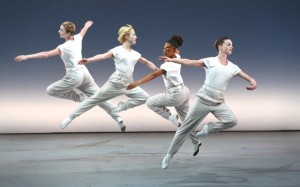 I was 15 minutes late for Friday night’s performance of Einstein on the Beach at BAM and had to stand in the back of the orchestra until the first “Knee Play” was over. I was then escorted to my aisle seat in row L.
I was 15 minutes late for Friday night’s performance of Einstein on the Beach at BAM and had to stand in the back of the orchestra until the first “Knee Play” was over. I was then escorted to my aisle seat in row L.
There I sat next to a man who was not happy about the woman who was texting next to him.
“I would prefer that you not do that,” he told her without rancor.
I could see his point. Einstein on the Beach, the 1976 masterpiece created by Robert Wilson, Philip Glass and Lucinda Childs, is an epic experience that requires fortitude, focus and a meditative openness and calm.
Give into it and it shimmers with resonance and meaning. Tweeting while viewing could be distracting. And it was obviously distracting to the man sitting next to me.
Which isn’t to say that there was a rigid, church-like, sanctimonious atmosphere at BAM. The audience is encouraged to wander in and out, which is a good thing since the opera lasts four hours and thirty minutes. There is no intermission but during scene changes people raced to the restrooms and lobby for bathroom and/or wine and snack breaks.
Some of the audience didn’t come back. The show can be a tad minimalist for some theater goers.
EOTB is, roughly, about Einstein, the theory of relativity, time, space, trains, spaceships, clocks, the atomic age, life, love…
It’s a non-narrative opera with a euphoric score by Philip Glass based on repeating harmonic and rhythmic structures for singers, keyboards, saxophones, and a lone virtuosic violin.
Einstein’s violin. A violinist dressed as Einstein sits on the stage through much of the opera playing Glassian arpeggios.
Set design, staging and lighting are by Robert Wilson and it’s visually stunning. “As with all of my work, the images you see on stage are not decoration; they’re architectural. At the very start there is a vertical bar of light that appears three times. Then, in the second scene, you have a horizontal bar of light. Together, they represent the cross of time and space: time shown as a vertical beam, space as a horizontal line,” Wilson told The Guardian recently.
But it’s the singers, actors, and the dancers, the dancers, who bring this minimalist classic to life. In two sections, the stage clears completely and the dancers leap across across in intersecting patterns with repeated simple, almost folkloric movements by Lucinda Child Their skipping, turning, leaping adds splendor to the music and the overall experience.
I’ve now seen EOTB three times. I saw it at BAM with my father in 1984. He’d seen the premiere at the Metropolitan Opera in 1976, where it played for one evening, an unforgettable experience. I think he longed to recapture the excitement of that evening and he was not disappointed. Seeing it with him in 1984 was a very special experience for me. I saw it again in 1992, also at BAM.
I’d forgotten how funny the opera is. It is timeless—and about time itself—but also very much of its time, filled with a slew of 1970’s references: NYC radio stations and DJs, Carole King, Crazy Eddie, Patty Hearst, Mr. Bojangles The man I sat next to is a theater professional, an avant gardeist. He, too, saw the original at the Metropolitan Opera all those years ago.
“A lot of people just hated it then,” he said. “But I was like, there’s something here. I found it so interesting,” he told me in the lobby when we both happened to take a drink break.
I tried to imagine what it was like to see the show in 1976. I also tried to imagine what people will think of it one hundred years from now. And I believe it will be performed one hundred years from now. Because it is, among other things, a work that depicts our time.
“Do you remember what happens at the very end?” the man asked me while we sipped our drinks.
“No, I don’t,” I told him as we walked back in.
“Wait till you see,” he said.
I had forgotten the ending, a story told by a bus driver on a two-dimensional bus. Indeed, it’s a curious and sweet ending: a story about love, a story about connection. A story that left the audience open to hope and transcendence as it exited into the Brooklyn night.
